Deities of Slavic religion
Deities of Slavic religion, arranged in cosmological and functional groups, are inherited through mythology and folklore. In modern Slavic Native Faith's theology and cosmology, gods are arranged as a hierarchy of powers begotten by the supreme God of the universe, Rod. The general Slavic term for "god" or "deity" is бог bog, whose original meaning, as scholar Mathieu-Colas clarifies, is "wealth".[1] Many Slavic gods have Indo-Iranian origin, and many are worshipped to this day in the countrysides despite longtime Christianisation of Slavic lands,[2] apart from the relatively recent phenomenon of organised Slavic Native Faith (Rodnovery).
Absolute God / Rod
| Concept | Name variations | Description | Image |
|---|---|---|---|
| Rod | Rid (Ukrainian), Sud (South Slavic), Prabog/Praboh (Slovak) / Hrodo, Chrodo, Crodo (Latinisation) | Absolute, primordial God of the universe and of all other gods. Supreme creator of all things and kins and their power of generation. Scholars have defined Rod as the "general power of birth and reproduction".[3] The root *rod means "birth", "origin", "kinship", "tribe" and "destiny". "Sud", literally "Judge", is a South Slavic name for the supreme God, especially when conceived as the interweaving of destiny. "Prabog/Praboh" is another name of the same concept, this time from the Slovak tradition, and literally means "Pre-God", "First-God".[1] | _Swastika_(%D0%A1%D0%B2%D0%B0%D1%81%D1%82%D0%B8%D0%BA%D0%B0)_-_Rodnovery.svg.png) Kolovrat, swastika, whirl, wheel and spiral symbols. Boris Rybakov also identifies the "six-petaled rose" and the thunder mark (gromovoi znak) as symbols of Rod and of his many forms (Svetovid, Perun, etc.).[4] .jpg) |
Highest cosmological concepts
Basic information from Mathieu-Colas 2017.[1] Further information is appropriately referenced.
Supreme polarity
| Concept | Name variations | Description | Attested among | Image |
|---|---|---|---|---|
| Belobog—Chernobog | Byelobog, Bielobog, Belibog, Bielbog, Bjjelbog / Chernabog, Chernebog, Chornobog, Chiernobog, Czernabog, Crnobog, Tsernobog, Zcernebog, Zernebog (Germanised Wendish),[5] Charnaglofy | Literally, respectively, "White God" (bieli, "white" + bog, "god") and "Black God" (cherni, "black" + bog). They represent the oppositional and complementary duality which inheres reality, expressed for instance as light and darkness, day and night, male and female. Belobog incarnates as Svarog ("Heaven") and the multitude of his manifestations (see "trinity and quadrinity" hereinbelow), while Chernobog incarnates as Veles (also called "Charnaglofy", i.e. "Black Head") and female deities.[6] | Baltic Slavs | _--_Maxim_Sukharev.jpg) |
| Rod–Rodzanicy | Rod-Rozanicy, Rod-Ro(d)zanitsy, Rod-Ro(d)zanica, Rod-Ro(d)zanitsa, "-e" ending variant in some Slavic languages (for instance, Polish "Rodzanice") | Literally "God and the Goddesses". Masculine singular plus feminine plural of the root *rod; it implies the union of the supreme God with mother goddesses in reality. "Rodzanicy", also combined together as a singular goddess "Rodzanica", who is an ancient mother goddess according to Mathieu-Colas, literally means the "Generatrixes" (singular: the "Generatrix").[1] They correspond to the three goddesses of destiny known among South Slavs as "Sudenicy". | East Slavs, Russes | 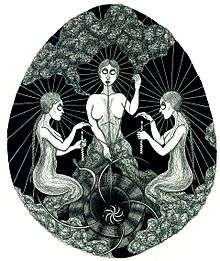 |
| Sud–Sudenicy | Sud-Sudenitsy, Sud-Sudenica, Sud-Sudenitsa, "-e" ending variant in some Slavic languages (for instance, Croatian "Sudenice") | "Sud" literally means "Judge"; God interpreted as the interweaving of destiny. "Sudenica", literally meaning "She who Judges", is his female counterpart and defines three goddesses (plural: "Sudenicy"), his daughters, that determine the fate of men at their birth.[1] It is the South Slavic equivalent of Rod-Rodzanicy. | South Slavs | - |
| Zhibog and Zhiva | Siebog, Sibog, Gibog, Jibog / Sieva, Sieba (Germanised Wendish),[5] Siva, Siwa, Giva, Jiva, Zivena, Zywie (Polish) | Incarnation of the supreme polarity specifically as male and female, whose interaction begets life. "Zhibog" literally means "Life God", "Life Dispenser", while "Zhiva" means "She who Lives". They are conceived as either siblings or spouses; gods of love, fertility and marriage. Mathieu-Colas compares Zhiva to the ancient Roman Ceres, and states that as "Zivena" she is the opposite facet of "Morana", i.e. Marzanna, the goddess of death (see "great goddesses" hereinbelow).[1] Her association with corn makes her identical to Mokosh or Mat Syra Zemlya, the great goddess of the deep ground.[6] The Polish Zywie is also presented as a goddess of healing. | East Slavs, Russes | .png) |
Heavenly threefold and fourfold
| Concept | Name variations | Polarity | Description | Attested among | Image |
|---|---|---|---|---|---|
| Triglav | Tryglav, Tryglaw, Triglau, Triglov, Triglaf | Male | A concept literally meaning "Three-Headed" (tri, "three" + glava, "head"). It represents three gods who personify the three worlds (Prav-Yav-Nav), or Heaven, Earth and the underworld,[6] and sovereignty over the three elements of air, water and soil.[1] The three heads are Svarog, Perun and Svetovid. Triglav is often represented riding a black horse.[7] As the union of the three dimensions of reality represented as a mountain or tree, Triglav was defined as summus deus ("summing god") by Ebbo; Dynda (2014) further defines Triglav as a conception of the axis mundi.[8] Adam of Bremen described the Triglav of Wolin as Neptunus triplicis naturae (i.e. "Neptune of the three natures/generations") attesting the colours that were associated to the three worlds: white for Heaven, green for Earth and black for the underworld.[9] Triglav also represents the union of the three dimensions of time: past, present and future as a whole.[10] | Baltic Slavs |  |
| Svarog | Schwayxtix (Germanised Wendish)[5] | Male | Literally "Heaven" (cf. Svarga), father of Dazhbog and Svarozhich or identical with them.[1] Compared to the Greco-Roman Saturn-Chronos, the time god.[6] | East Slavs, Russes | .jpg)  "Square of God/Heaven"  "Hands of God/Heaven" |
| Perun | Piorun (Polish), Peraun (Czech), Peron (Slovak), Prono (Latinisation), Percunust (Germanised Wendish)[5] | Male | Literally "Thunder". Son of Svarog, worshipped as the god of war. Cognate of Baltic Perkunas; Scandinavian Thor.[1] He is the opposite polarity of Veles, the male god of the Earth. In some traditions, he has a mother, Percunatele (a goddess inherited from Baltic traditions) and a sister Ognyena Maria ("Fiery Mary"), goddess who receives the fire. | - |   |
| Svetovid | Svetovit, Svantovit, Svantevit, Sviatovit, Swatowit | Male and female | God of war, light and power. A major temple dedicated to him was located at Cape Arkona. The name literally means "Lord of Power" (svent, "power", "force" + vit, "lord"),[1] but also "Lord of Holiness" as svent means both strength and holiness in Slavic. Two of his heads are male (northern/white Svarog and western/red Perun) and two female (southern/black Lada and eastern/green Mokosh). They represent the four directions of space, the four seasons of the year, and the four Russias of sacred geography.[6] Dynda(2014) describes Svetovid as the perfect representation of the Slavic cosmological conception of the axis mundi, as symbolising the union of the four directions of space and the three dimensions of reality (Heaven, Earth and the netherworld).[11] Svetovid is also represented riding a white horse.[7] | Baltic Slavs |  |
| Dazhbog / Hors | Dazhdbog, Dajbog, Dambog, Dabog (Serbian) / Khors, Chors, Khursu | Male | Literally "Giving God", "Day God". Solar deity, son of Svarog, winner of darkness, warranter of justice and wellbeing. Mathieu-Colas interprets the theonym as "Wealth Giver", from dati, "giving" + bog, "god", "wealth".[1] Leeming (2005) identifies him as the same as Hors, god of the sun and of the thunderbolt. He changes from a young man to an old man as he travels the sky; he has two daughters accompanying him, the two Zvezda ("Morning Star" and "Evening Star"), and has a brother, the bald "Moon God" (Juthrbog).[6] | East Slavs, Russes |  |
| Ognebog / Svarozhich | Ogne, Ogni / Svarogitch, Svarojitch | Male | "Ognebog" (literally "Fire God") is the Slavic equivalent of the Hindu god Agni.[12] He is often equated with Simargl. "Svarozhich" literally means "Son of Heaven" (Svarog), is always identified as the god of fire, and tutelary deity of Baltic Slavs.[1] It may be an epithet of many heavenly gods, among whom Perun, Svetovid or Dazhbog. | - | - |
Goddesses
Basic information from Mathieu-Colas 2017.[1] Further information is appropriately referenced.
Great goddesses
| Concept | Name variations | Description | Attested among | Image |
|---|---|---|---|---|
| Devana | Dewana, Diewana, Debana, Diiwica (Serbian), Dziewona, Dziewanna (Polish) | Goddess of hunting and of the forests. Etymologically cognate of the Roman Diana, and functionally correlated with the Greek Artemis.[13] | West Slavs; Czechs, Slovaks |  |
| Dodola | Doda, Paparuda, Perperuna, Perperusha / Didilia, Didilla, Zizilia (Polish) / Dzydzilelya, Dzidzilelya | Goddess of the rain, wife of Perun. Probably related to Dodol, the male god of the air.[1] According to Vyacheslav Ivanov and Vladimir Toporov, Dzydzilelya is the West Slavic equivalent of the southern name Dodola.[14] Dzydzilelya is known as the goddess of wedding and tutelary of infancy among West Slavs; her name comes from dziecilela, "she who pampers babies".[1] Didilia is another goddess known among West Slavs as the tutelary of love and fertiliy, compared to the Roman Venus or Lucina.[1] | South Slavs, Serbians; West Slavs, Poles | 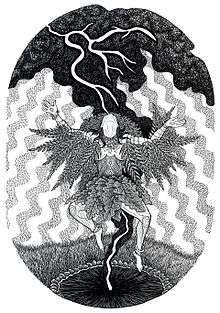 |
| Kupala | Kupalo (if male), Kupalnitsa / Solntse | Goddess representing the mighty Sun of summer solstice, of joy and water. Celebrated on Kupala Night with rituals of purification through water and fire. She is seldom represented as male, and the name "Kupala" or "Kupalo" is etymologically cognate of the Greek Apollo. "Solntse" (simply "Sun", but often translated Phoebus) is another name of the goddess or god of the fully bright Sun.[1] | - | 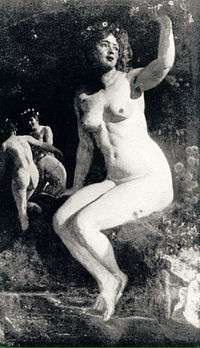 |
| Lada | Lado, Ladon (if male) | Polyfunctional great goddess of the Earth, harmony and joy, symbolising youth, spring, beauty, fertility and love. Mother of twins (Dido and Dada). Mother or wife of Lado (Mathieu-Colas says that among Slavs there is evidence that Lado is the same as Lada conceived as male; he is represented as a phallic god, same as Veles?).[1] She is the female sounterpart of Svarog.[6] According to scholars such as Boris Rybakov, Lada is cognate of Greco-Roman Leto, Latona, and is possibly the same as Rod's supreme counterpart Rodzanica.[4] | Slavs and Balts | .1998%D0%B3.29%2C6%D1%8520%2C2.jpg) |
| Marzanna | Mara, Morana, Morena, Maslenitsa, Marowit, Marzyana (Polish) / Baba Yaga | Rural goddess who grows sprouts; otherwise goddess of winter and death if identified as the same as Morana. Her opposite is Zivena (i.e. Zhiva). "Marowit" is another name of Marzanna or her male counterpart, attested among the Wends.[1] Baba Yaga is also the goddess of death, both young and old, associated both with birds and snakes. According to Leeming (2005), who relies upon Marija Gimbutas, she is clearly cognate of the Hindu goddess Kali as the deathly aspect of the great goddess of Old Europe.[6] | Poles |  |
| Mokosh / Mata Syra Zemlya | Makosh, Mokosi, Mokysha, Mokusha[6] / Mati Syra Zemlya, Mat Zemlya, Zeme, Matka | Mother goddess associated with female works (notably weaving) and harvest.[1] She is also the goddess of corn and moist, the "Corn Mother". Her name literally means "Wetness" and she is also known by the title "Mat Syra Zemlya" ("Damp Mother Earth") or "Matka" (diminutive). She was transformed into the Black Madonna, very popular in Poland, with Christianisation.[6] | East Slavs, Russes |  |
Other goddesses
| Concept | Name variations | Description | Attested among | Image |
|---|---|---|---|---|
| Chislobog | Zislobog, Zislbog (Germanised Wendish)[5] / Kricco (Wendish) | Literally "Number Goddess", of time calculation and of the lunar month. Represented as a female holding a moon.[1] "Kricco" is the Wendish name of the same goddess. | - | - |
| Karna | - | Goddess of the funerals, personifying tears. Compared to the Hindu god Karna.[1] | - | - |
| Kostroma | - | Goddess of spring and fertility.[1] | East Slavs, Russes |  |
| Lelia | - | Goddess of spring and mercy, daughter of Lada.[1] According to Boris Rybakov, Lelia is the closest equivalent of the Greek Artemis,[4] being associated with the Ursa Major constellation. | - | - |
| Matergabia | Matergabiae | Literally "Fire Mother". Goddess of the hearth.[1] Cf. the Roman Vesta. | Slavs and Balts | - |
| Ozwiena | - | Goddess of the echo,[1] and generally of voice and human communication. | - | - |
| Slata Baba | Zlata Baba, Zolotaya Baba | Her name literally means "Golden Old Lady". She is worshipped among Finno-Ugric populations along the Ob River, but also among Slavs.[1] | Finno-Ugrics and Slavs | .png) |
| Uroda | - | Goddess of ploughed land (agriculture).[1] | West Slavs; Slovaks | - |
| Ursula | Ursala, Orsel, Horsel | Goddess of the moon associated to the astral Little Bear. Compared to the German goddess Urschel and the Greek Artemis.[1] | - | - |
| Veliona | Veliuona, Velonia, Vielona, Vielonia / Velnias (Lithuanian), Velns (Latvian) | Goddess of death, warden of the souls of the ancestors. Though the name seems feminine, the polarity of the god(dess) is not sure. Among the Balts, Velnias or Velns is male, but there is a "Velu Mate" ("Mother of the Souls") as well.[1] | Slavs and Balts | - |
| Vesna | - | Goddess of spring.[1] | - | 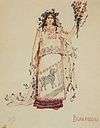 |
| Zimtserla | - | Goddess of spring or of the polar lights. The second function would make her identical with Zorya.[1] | - | - |
| Zroya | - | Virgin goddess of war, associated with Perun.[1] | - | - |
Other gods
Basic information from Mathieu-Colas 2017.[1] Further information is appropriately referenced.
Other important masculine gods
| Concept | Name variations | Description | Attested among | Image |
|---|---|---|---|---|
| Chur | - | God of boundaries and of the delimitation of properties.[1] Cf. the Roman Terminus. | - | - |
| Dogoda | - | God of the west wind.[1] | - | - |
| Erisvorsh / Varpulis | Erishvorsh, Erivorsh / Warpulis | God of the holy storm, wind and thunder. Aspect, name, or associate of Perun.[1] | - | - |
| Flins | Flyns | A god of death which may be a Wendish name of Veles, although the iconography is rather different. The three symbols of Flins' icon are the lion, the skull and the stone.[5][15] | West Slavs; Wends | |
| Ipabog | - | Literally "Hunt God".[1] | - | - |
| Juthrbog | - | Literally "Moon God".[1] The theonym may refer to Yarilo as the good of the moon or to Chernobog, as the good of darkness and of the moon, as opposite to the god of the Sun. | West Slavs; Wends | - |
| Koliada | Kolyada, Koljada, Koleda, Ovsen | God representing the young, winter Sun returning after solstice.[1] The name is thought to derive from Greek kalanda, later Latinised as calendae.[16] | Slavs and Balts | - |
| Kresnik | Krsnik | God of fire and of the Sun. Possibly another name of Svarozhich.[1] | South Slavs, Serbians | - |
| Morskoy | Morskoy-Czar, Czar Morskoy | God of the sea. "Morskoy" means "King of the Sea" and "Morskoy Czar" means "Emperor (cf. Latin Caesar) King of the Sea". Compared to the Greco-Roman Poseidon-Neptune.[1] | East Slavs, Russes |  |
| Ny / Pekelnybog | Nyja, Nija / Peklenc, Pekelnipan, Pekelnik, Lokton | Ny is the god of the underworld who acts as psychopomp, i.e. taking souls to the underworld. Mathieu-Colas gives the name "Nyja" as the classic standard,[1] however in modern Slavic Native Faith the name "Ny" is prevalent. Pekelnybog is another name of the god of the underworld, associated with subterranean fire and water, snakes and earthquakes. | West Slavs; Poles | - |
| Porewit | Porevit, Porevith, Porovit, Puruvit, Porevithus (Latinisation), Porenut, Porenutius (Latinisation), Proven, Prove (Germanisation) / Turupit, Tarapita | The god is depicted with five faces, one of which is on his chest. A cult centre of Porewit was at Garz, in Rügen. The name means "Lord of Power" (por, "power", "potence" + vit, "lord"), synonymous with "Svetovid". As the Germanised "Proven" or "Prove" he is attested as the tutelary deity of Oldenburg.[1] Leeming (2005) says that he represents south and summer, and provides alterations of the name linking him to the Finnic god Tharapita; according to him "Proven" fully identifies as Perun, making Porewit an aspect or another name of Perun.[17] | Baltic Slavs | .jpg) |
| Pozvizd | Pohvist, Poshvist, Posvist, Pogvist | God of the wind, otherwise called "Russian Star". The name literally means "Whistler" or "Blower".[1] | East Slavs, Russes | - |
| Pripegala | - | Cognate of the Greco-Roman Priapus.[1] | Baltic Slavs | - |
| Radegast | Radigast, Redigast, Radegaste, Radigost, Riedegost, Radogost, Radhost | God of honour and hospitality. He was the tutelary deity of the Redarians.[1] | Baltic Slavs | 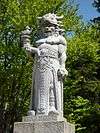 |
| Rugiewit / Karewit | Rugievit, Rujevit, Rugiwit, Rugievithus (Latinisation), Ruevit, Rinvit / Karevit | Warrior god and tutelary deity of Rügen. The name literally means "Lord of Rugia". Like Porewit, he had a cult centre in Garz. Another name or aspect of Rugiewit is "Karewit" ("Lor of Charenza").[1] Rugiewit himself is perhaps an aspect of Svetovid; he represents east and the fall season. He is often represented with seven heads.[17] | Baltic Slavs |  |
| Simargl / Pereplut | Simarg, Simarigl, Simargle, Semargl | Chimerical or draconian figure compared to the Persian Simurgh. Also known as Pereplut, a figure not well identified in historical sources, he may be a god of fortune and drinking, abundance and vegetation, or more commonly a tutelary deity of sailors.[1] Zirnitra, also called Rosvodiz, is a black dragon god of magic. | East Slavs, Russes |  |
| Stribog | Strybog, Strzybóg (Polish) | God of winds and storms. His name, like that of Dazhbog, means "Wealth Dispenser" (sterti, "spread" + bog, "god", "wealth").[1] | East Slavs, Russes | - |
| Veles | Weles, Volos, Walgino (Polish) / Charnaglofy / Skotibog / Zembog | Chthonic god of cattle, but also master of the forest and of wild animals, and god of commerce.[18] The Book of Veles is dedicated to him. "Walgino" is the name of the cattle god in Polish tradition,[1] though "Weles" is more common nowadays. Also known as the "Horned God", Veles is a male god of the Earth, incarnating the "Black God" of dual theology. As such he is the opposite of the heavenly manifestations of the "White God" (Svarog and his sons, but especially Perun).[6] An alternative name of Veles that was used by Baltic Slavs is "Charnaglofy" ("Black Head", also spelled "Tjarnaglofy"; cherni + glowa, "head").[13] The name "Skotibog" literally means "Herder God". The name "Zembog" literally means "Earth God"[1] and may refer to Veles. | East Slavs, Russes |  |
| Yarilo / Gerowit / Myesyats / Juthrbog | Yarylo, Jarilo, Jarylo, Jaryla / Gerovit, Gerovitus (Latinisation), Yarovit, Jarovit, Jerovit, Dzarowit / Messiatz | God of spring, sexuality and fertility. His alternate name "Gerowit" literally means "Strong/Wroth Lord" (ger / jar, "strong" or "wrathful" + vit, "lord") and was popular among Baltic Slavs. As such he was also regarded as a warrior god and is attested as the tutelary deity of Wolgast.[1] Leeming (2005) says that as Gerowit he represents west and spring, and compares him to the Greek (of Eastern origin) Adonis-Dionysus as the god of youth, death and resurrection.[6] Kostrubonko is another East Slavic god, or another name of Yarilo, with the same functions of spring and fertility, death and resurrection.[1] Under the name "Myesyats" he is a god of the moon. | - |  |
Other twosomes and threesomes
| Concept | Name variations | Polarity | Description | Attested among | Image |
|---|---|---|---|---|---|
| Dido and Dida | Lado and Lada | Male/female | Divine twins, just siblings or even spouses, sons either of Lado and Lada, or just of Lada, or rather identical with Lado and Lada themselves. Dido is attested in some traditions as the husband of goddess Lada.[13] | Slavs and Balts | - |
| Dolya—Nedolya | Dola-Nedola | Female | Goddess of destiny. When she is positive she is named "Dolya", when negative she turns into "Nedolya". The same are known as "Srecha" and "Nesrecha" among South Slavs.[1] | East Slavs, Russes | Christianised "Saint Nedolya" in a 19th-century Bulgarian icon. |
| Srecha—Nesrecha | Sretcha-Nesretcha | Female | Goddess of destiny; the South Slavic equivalent concept of "Dolya" and "Nedolya".[1] | South Slavs | - |
| Zorya | Zoria, Zaria, Zarya, Zora | Female | Husain (2003) documents "Zaria" as the goddess of beauty.[19] Literally "Light" or "Aurora" (golden, northern lights), it is the name of three goddesses, daughters of Dazhbog and sisters of Zvezda, with whom they are often conflated:[1]
|
- | - |
| Zvezda | Zwezda (Polish) | Female | Literally "Star". It is the name of two sister astral goddesses often conflated with Zoria:[1]
|
- | - |
Tutelary deities of specific places, things and crafts
Basic information from Mathieu-Colas 2017.[1] Further information is appropriately referenced.
Deities of waters and woods
| Concept | Name variations | Polarity | Description | Attested among | Image |
|---|---|---|---|---|---|
| Bereginia | Beregynia, Berehynia (Ukrainian) | Female | Originally tutelary deity, or deities, of waters and riverbanks (cf. Old Russian beregu, "bank, shore").[1] In modern Ukrainian Native Faith she has been heightened to the status of a national goddess "hearth mother, protectoress of mother earth".[20] Some scholars identify Bereginia as the same as Rusalka.[21] | East Slavs, Russes |  |
| Boginka | Bogunka (Polish), Nemodlika (Bohemian, Moravian), Rusalka, Vodianoi, Vodianoy (East Slavs) | Female | Literally "Little Goddess", plural boginki ("little goddesses"), are tutelary deities of waters, generally mischievous. Rusalka and Nemodlika are other names of the same concept. "Nemodlika" literally means "She Who Doesn't Ask".[1] | - |  |
| Leshy / Boruta | Leshuk (Belarussian), Leszy, Leśny (Polish) | Male | Tutelary deity of forests, with a wife (Leshachikha) and children (Leshonky). Other gods of woods are Berstuk (among Wends), Modeina and Silinietz (Poles), Sicksa and Zuttibur.[1] Boruta is another name of the same god of wood and hunting, and is also attested in the variant "Borewit", by which he is considered to be the same god as Porewit. Cf. the Greek Pan. | - |  |
| Polevik | Polevoy, Datan, Lawkapatim, Tawals / Poludnitsa (female) | Male / female | Tutelary deity of fields (from polé, "field"). Among Poles the god of the fields is also known as "Datan", "Lawkapatim", or "Tawals". Poludnitsa is his female form; tymologically deriving from poluden or polden, not only related to fields but also, literally, "midday" (cf. "Lady Midday"). The name "Lawkapatim" reflects the Prussian "Laukosargas".[1] | - |  |
Deities of settings and crafts
| Concept | Name variations | Polarity | Description | Attested among | Image |
|---|---|---|---|---|---|
| Domovoi and Domovikha, and other concepts of household deity | Domovoy, Domovoj / Domania, Kikimora, Volossatka (pertaining to Veles), Marukha | Male/female | Domovoi is the foremost household deity, warden of the hearth. The etymological root *dom produces many words pertaining to the semantic field of "abode", for instance Latin domus. Domania is his wife. According to Soviet-era Russian folklorist E. G. Kagarov, Domovoi is a conceptualisation of the supreme Rod itself as the specific family lineage and its stead.[22] There is general agreement among scholars that the Domovoi originates as a deified fountainhead ancestor, and that all other household deities with specific functions are extensions of him.[23] Others such gods are Dvorovoi (tutelary deity of courtyards[1]), Bannik ("Bath Spirit", tutelary deity of the sauna, corresponding to the Komi Pyvsiansa[1]) and Ovinnik ("Threshing Barn Spirit"),[24] Prigirstitis (known for his fine hearing), and goddess Krimba among Bohemians. Another lizard-shaped household deity is called Giwoitis.[1] Among Poles, the goddess of the house is also known as Matka Gabia, originally a Lithuanian figure. | - |  Domovoi Domovoi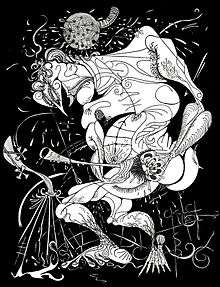 Bannik Bannik Ovinnik Ovinnik |
| Dugnay | Dugnai | Female | Tutelary deity of bread and bakery.[1] | Slavs and Balts | - |
| Julius | - | Male | Tutelary deity of Wolin.[1] He is the deified Julius Caesar, who was worshipped as the supposed founding ancestor of the city. The name of the city in medieval Latin texts is "Iulin", allegedly a derivative of "Julius". In Wolin was situated a wooden pillar with an ancient lance hewn into it; the lance allegedly belonged to Julius Cesar. Dynda (2014) finds in this Julius' pillar another representation of the axis mundi, of the Triglav.[25] | Baltic Slavs | - |
| Krugis | Krukis, Kriukis | Male | Tutelary deity of blacksmiths (and pets).[1] | - | - |
| Pizamar | - | Male | Tutelary deity of Asund, in Rügen.[1] | Baltic Slavs | - |
| Podaga | - | Male | Tutelary deity of hunting and fishing. Attested as the tutelary deity of Plön.[1] | Baltic Slavs | - |
Deities of animals and plants
| Concept | Name variations | Polarity | Description | Attested among | Image |
|---|---|---|---|---|---|
| Kirnis | - | Male | Tutelary deity of cherries.[1] | Slavs and Balts | - |
| Kremara / Priparchis | - | Male | Tutelary deity of pigs.[1] | West Slavs; Poles | - |
| Kurwaichin | - | Male | Tutelary deity of lambs.[1] | West Slavs; Poles | - |
| Pesseias | - | Male | Tutelary deity of pets.[1] | - | - |
| Ratainitsa | Ratainycia | Male | Tutelary deity of horses.[1] | West Slavs; Poles (dubious) | - |
| Zosim | - | Male | Tutelary deity of bees.[1] | - | - |
Germanic deities
The Wends, including those living in Germany and later Germanised, or the never-Germanised West Slavs, also worshipped deities adopted from Germanic religion, as documented by Bernhard Severin Ingemann. However, Germanic gods never rose to prominence over Slavic ones in Wendish religion.[5]
| Concept | Name variations | Polarity | Image |
|---|---|---|---|
| Woda[5] | Wotan (German), Woden (English), Odin (Scandinavian) | Male | - |
| Balduri[5] | Baldag (German), Beldeg (English), Baldur (Scandinavian) | Male | - |
| Hela[5] | Holle (German), Hell (English, Scandinavian) | Female | - |
See also
Sources
Citations
- 1 2 3 4 5 6 7 8 9 10 11 12 13 14 15 16 17 18 19 20 21 22 23 24 25 26 27 28 29 30 31 32 33 34 35 36 37 38 39 40 41 42 43 44 45 46 47 48 49 50 51 52 53 54 55 56 57 58 59 60 61 62 63 64 65 66 67 68 69 70 71 72 73 74 75 76 77 Mathieu-Colas 2017.
- ↑ Leeming 2005, p. 359–360.
- ↑ Ivanits 1989, pp. 14–17.
- 1 2 3 Ivanits 1989, p. 17.
- 1 2 3 4 5 6 7 8 9 10 Ingemann 1824.
- 1 2 3 4 5 6 7 8 9 10 11 12 Leeming 2005, p. 360.
- 1 2 Dynda 2014, p. 59.
- ↑ Dynda 2014, p. 64.
- ↑ Dynda 2014, p. 63.
- ↑ Dynda 2014, p. 74.
- ↑ Dynda 2014, p. 62.
- ↑ Khmara, Anatoly Vladimirovich (2008). "Образование: гуманитарные дисциплины, творчество и созидание (Education: Humanities, Creativity and Creation)". Образование через всю жизнь: непрерывное образование в интересах устойчивого развития (Education Throughout Life: Continuing Education for Sustainable Development). p. 68
- 1 2 3 Mathieu-Colas 2017; Leeming 2005, p. 360.
- ↑ Vyacheslav Ivanov, Vladimir Toporov. "Slavic Mythology (Славянская мифология)". Russian Encyclopedia (Российская энциклопедия), 1994.
- ↑ Boryna, M. Boski Flins na Dolnym Śla̜sku, Łużycach i w Saksonii. Szprotawa, 2004
- ↑ Hubbs, Joanna (1993). Mother Russia: The Feminine Myth in Russian Culture. Bloomington: Indiana University Press. ISBN 9780253208422. p. 64
- 1 2 Leeming 2005, p. 359.
- ↑ Ivanits 1989, pp. 13, 17.
- ↑ Husain, Shahrukh (2003). The Goddess: Power, Sexuality, and the Feminine Divine. University of Michigan Press. ISBN 9780472089345. p. 170
- ↑ The hypothesis that Berehynia is a historical Slavic goddess is argued by Halyna Lozko leader of the Federation of Ukrainian Rodnovers. "Archived copy". Archived from the original on 2011-07-20. Retrieved 2007-09-20.
- ↑ Ivanits 1989, p. 78.
- ↑ Ivanits 1989, p. 14.
- ↑ Ivanits 1989, p. 61.
- ↑ Ivanits 1989, p. 58.
- ↑ Dynda 2014, p. 61.
References
- Dynda, Jiří (2014). "The Three-Headed One at the Crossroad: A Comparative Study of the Slavic God Triglav" (PDF). Studia mythologica Slavica. 17. Institute of Slovenian Ethnology. pp. 57–82. ISSN 1408-6271. Archived from the original (PDF) on 7 July 2017.
- Ingemann, B. S. (1824). Grundtræk til En Nord-Slavisk og Vendisk Gudelære. Copenhagen.
- Ivanits, Linda J. (1989). Russian Folk Belief. M. E. Sharpe. ISBN 9780765630889.
- Leeming, David (2005). The Oxford Companion to World Mythology. Sydney: Oxford University Press. ISBN 9780190288884.
- Mathieu-Colas, Michel (2017). "Dieux slaves et baltes" (PDF). Dictionnaire des noms des divinités. France: Archive ouverte des Sciences de l'Homme et de la Société, Centre national de la recherche scientifique. Archived from the original (PDF) on 4 August 2017. Retrieved 24 May 2017.
